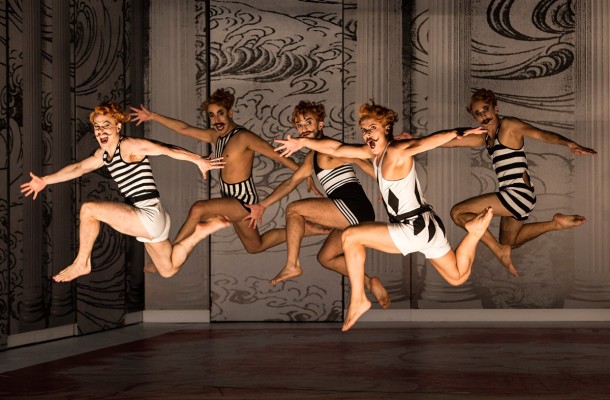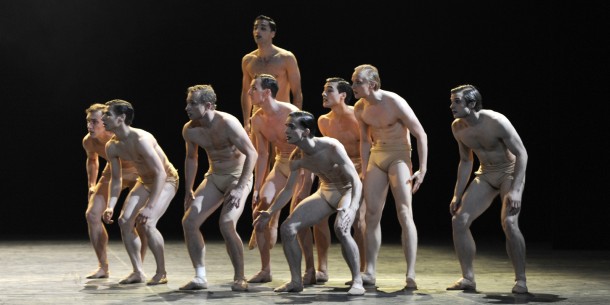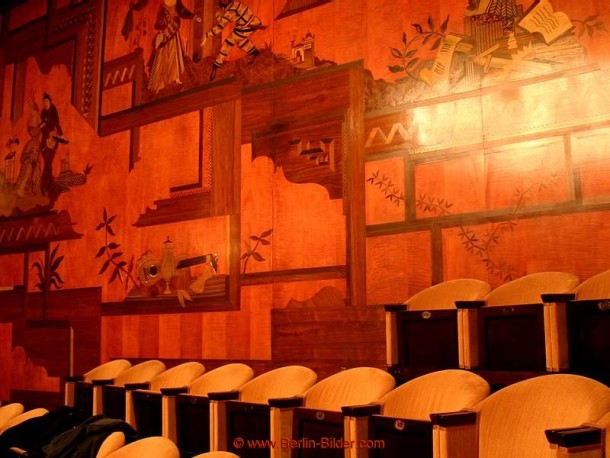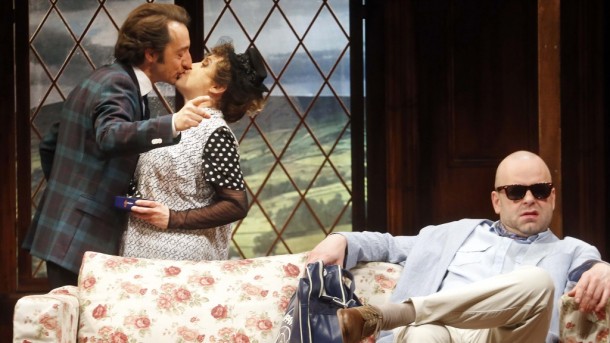Jacques Offenbach’s Die Schὃne Helena at the Komische Oper was totally sold out well in advance of the October 2014 premiere and remains a popular feature at that theatre. The Australian director Barrie Kosky’s previous operettas were very popular, and this was advertised as “Monty Python ἁ la francaise”
The operetta was performed with great vitality by a large cast that literally filled the stage and was composed of every type of character from clowns to singers wearing enormous masks, many women in sexy costumes, and a quintet of men with identical wigs on roller skates. The action started with a bang and could be described as hectic. Kosky seemed to have taken the legendary director George Abbott’s advice: make it fast and have lots of doors.

Jacques Offenbach’s Die Schὃne Helena at the Komische Oper Berlin directed by Barrie Kosky. Photo credit: Iko Freese
As Helen of Troy, Nicole Chevalier was certainly beautiful and had a lovely voice. She was gorgeously dressed in Buki Shiff’s costumes starting with a silver lamé backless evening gown and including a sparkling silver bathing suit. Her performance was sprightly and engaging, but too often she worked for a laugh by snarling something coarse, often in English. As she made her escape with Paris by climbing a ladder to the balcony of the auditorium, one could imagine her saying “goddam ladder and long skirt.”
An audience favorite was Stefan Sevenich as the augurer Kalchas. A large man, he was padded to be enormously fat, but was nonetheless capable of prancing, dancing, roller-skating and taking pratfalls. In the last scene with everyone in bathing suits, he appeared in patterned long underwear, daubing his face with sunscreen and flirting with the audience.
Offenbach’s delightful music was fully realized by the marvelous orchestra under the direction of Henrik Nànàsi. The arias were performed with broad comic business. When Helen and Paris were at last alone, they sang a duet and each ripped off pieces of clothing and threw them upstage. As Helen stood looking like an ad for Victoria’s Secret and Paris was reduced to shorts and red socks, their frantic lovemaking was interrupted by the arrival of Menelaus.
In contrast to the recent premiere of Tosca, which was booed throughout, the audience responded with cheers and stamping feet, absolutely delighted with a production, which will apparently be another success for Kosky.
The staging of Tosca at the Staatsoper Unter den Linden (now performing at the Schiller Theater) by Carl Rihas had been in the repertory for 38 years. So a new production directed by the Latvian Alvis Hermanis was commissioned. It opened on October 3, 1914, to a mixed reception. There may have been people in the audience who objected to the replacement of the Rihas staging. There was a mixture of boos and cheers which increased during the curtain calls. But by the seventh performance later in the month, the boos had ceased.
Hermanis is described as the master of hyper-realistic staging and surrealistic theatre. He is remembered for his Cosí fan Tutte at the Komische Oper last season, which featured huge semi-pornographic pictures of paintings above and behind the singers. His concept for Tosca involved a screen above and behind the stage on which continuously changing photographs and drawings were projected. These included enormous faces and bodies, photographs of building interiors, lovers kissing, and many drawings of people interacting in various ways. When Scarpia pressed his attentions on Tosca there was a picture of a man pursuing a woman. When the chorus of children came onstage in the church, there was a projection of happy children playing ring around the rosy. Act 2 began with a picture of a woman’s face with a herd of sheep in front of her. At the end, Tosca did not leap to her death but stood at the front of the stage with her arms raised, while behind her was a picture of a body lying on a sidewalk.

Michael Volle (Scarpia) and Anja Kampe (Tosca) in Tosca at the Berlin Staatsoper im Schiller Theater directed byAlvis Hermanis.
Photo credit: Hermann & Clärchen Baus
The pictures were a dominating visual element and had the effect of making the performers on the sparsely furnished stage seem diminutive. A young woman near me said she found the pictures simply distracting. However, the music and the singing were thrilling, making it clear why Tosca remains so popular. Daniel Barenboim conducted the premiere, but Domingo Hindoyan led some later performances. As Tosca, Anja Kampe was everything one could wish for. She was lovely to look at in the modern evening gown she wore throughout; she was an excellent actress, and her voice was wonderful. Scarpia is, of course, a marvelous and demanding role and Michael Volle dominated the scenes in which he sang with his rich baritone voice and commanding manner. As usual, all the performers from the Kinderchor of the Staatsoper to the smaller roles were excellent. It was not surprising that given the controversial design plus the high quality of the singers and orchestra that tickets were hard to come by with people standing outside the theatre hoping to get in.
The Staatsballett Berlin has no fixed home but performs in the locations for the three opera companies. It is hoped that the Oper Unter den Linden, now under restoration, will once again be the home for opera and ballet by 2016. The Open Square was performed at the Komische Oper and has been a very popular draw. Now in its second season, it appeals to a wide range of theatregoers including young couples, older regular visitors, and families with children.
The evening began with a man bursting onto the dark stage desperately discussing problems of music and dance and the question of whether dancers are artists or marionettes. Soon the stage filled with female dancers in pretty costumes of flashy, sequined material cut like tutus. These were the only costumes, as all the performers for the rest of the evening were seemingly nude. The costumes were seen once more as the females danced alone and were then joined by men wearing those same costumes.
There was no scenery, but the lighting provided visual interest, ranging from semi-darkness to bright shafts of light. In one scene the floor was covered with small lights through which the dancers moved and which were then carried by the dancers as they moved around the stage. There were many very dramatic effects of that type.
The dance involved vigorous movement (with male dancers leaping from behind male and female dancers over their heads), which contrasted with slow, languorous sections with individuals or couples often on the stage floor. The performance lasted over an hour with no intermission and concluded with an exuberant scene with all twenty dancers, the music and the dancing building in intensity until the final blast. The audience whistled, shouted, and stamped their feet through ten curtain calls which seemed to be the end, but the audience demanded still more calls with the apparently nude dancers in a line across the stage.
People thinking of theatre in Berlin generally think of the Deutsches Theater, the Gorki Theater, and the Berliner Ensemble, but there are numerous other professional theatres of high quality with many types of plays. Among these is the Renaissance Theater, which is described in press releases as “the smallest of the big theatres” and “The Jewel of Theatrical Architecture.” Here first-rate actors perform in plays of a wide variety.
The theatre was created in 1922, but redesigned in its present form in 1927 by architect Oskar Kaufmann. Its intimate style is enhanced by the interior decoration by artist César Klein. The curved wall behind the dress circle is of pink rosewood with inlays of theatrical figures. The theatre escaped major damage in the war so it exists as what the managers describe as “evidence of the flourishing theatrical life during the 1920’s” and “Europe’s only art-deco theatre.”
The theatre presents plays in repertory, many of which are American or English, performed in German. Recent seasons have included Who’s Afraid of Virginia Woolf?, The Glass Menagerie, and Michael Frayn’s Democracy. Frayn has achieved great popularity in Germany. In biographical notes about him, it is generally noted that he studied philosophy at Cambridge with Wittgenstein. His play Noises Off (called Der Nackte Wahnsinn in German) is often performed.
In the program for the play, Frayn was quoted as saying that in the first presentation in London in 1982, the play was viewed as a parody of a British sex farce that would not be playable outside of Britain. How wrong that was! Frayn mentioned productions in Korea, Japan, Australia and elsewhere, saying that the theme is universal.
I wondered if I should see this production, as I had seen wonderful productions of it in London and New York. There was no need to worry: the translation and the cast seemed perfect. The physical demands on the actors are remarkable: running up and down stairs, slipping on sardines and falling, crawling backstage past a window opening on the stage from which a blind has been torn off, all at a break-neck pace, and yet seeming so effortless—everything goes right while everything in the play within a play everything goes wrong. The audience was laughing nearly constantly, and I could not remember when I had laughed so much.
Katharina Thalbach (whose experience ranges from performing Shakespeare to acting as Intendant at the Gorki Theater) played Dotty, the dotty housekeeper with her endless plates of sardines. Her excellent performance was equaled by a cast, which includes some regulars of the Renaissance Theater. The beauty of the architecture and the high quality of the productions made this a Berlin theatre to remember.
has long had an interest in theatre and opera in Germany. She was the American Consultant for The Iceman Cometh at the Deutsches Theater. She presented several lecture performances for Amerika Haus including “Eugene O’Neill Onstage,” “American Women Playwrights,” and “Tennessee Williams’ South” which she now performs in Europe and America. She has written twelve books and continues writing and presenting papers at conferences.
European Stages, vol. 4, no. 1 (Spring 2015)
Editorial Board:
Marvin Carlson, Senior Editor, Founder
Krystyna Illakowicz, Co-Editor
Dominika Laster, Co-Editor
Editorial Staff:
Elizabeth Hickman, Managing Editor
Bhargav Rani, Editorial Assistant
Advisory Board:
Joshua Abrams
Christopher Balme
Maria Delgado
Allen Kuharsky
Jennifer Parker-Starbuck
Magda Romańska
Laurence Senelick
Daniele Vianello
Phyllis Zatlin
Table of Contents:
- Report from Berlin by Yvonne Shafer
- Performing Protest/Protesting Performance: Golgota Picnic in Warsaw by Chris Rzonca
- A Mad World My Masters at the Barbican by Marvin Carlson
- Grief, Family, Politics, but no Passion: Ivo van Hove’s Antigone by Erik Abbott
- Not Not I: Undoing Representation with Dead Centre’s Lippy by Daniel Sack
- In the Name of Our Peasants: History and Identity in Ukrainian and Polish Contemporary Theatre by Oksana Dudko
- Performances at a Symposium: “Theatre as a Laboratory for Community Interaction” at Odin Teatret, Holstebro, Denmark, May, 2014 by Seth Baumrin
- Songs of Lear by the Polish Song of the Goat Theatre by Lauren Dubowski
- Silence, Shakespeare and the Art of Taking Sides, Report from Barcelona by Maria M. Delgado
- Little Theatres and Small Casts: Madrid Stage in October 2014 by Phyllis Zatlin
- Gobrowicz’s and Ronconi’s Pornography without Scandal by Daniele Vianello
- Majster a Margaréta in Teatro Tatro, Slovakia by Miroslav Ballay
- Remnants of the Welfare State: A Community of Humans and Other Animals on the Main Stage of the Finnish National Theatre by Outi Lahtinen
- Mnouchkine’s Macbeth at the Cartoucherie by Marvin Carlson
- Awantura Warszawska and History in the Making: Michał Zadara’s Docudrama, Warsaw Uprising Museum, August, 2011 by Krystyna Illakowicz and Chris Rzonca
Martin E. Segal Theatre Center:
Frank Hentschker, Executive Director
Marvin Carlson, Director of Publications
Rebecca Sheahan, Managing Director
©2015 by Martin E. Segal Theatre Center
The Graduate Center CUNY Graduate Center
365 Fifth Avenue
New York NY 10016






